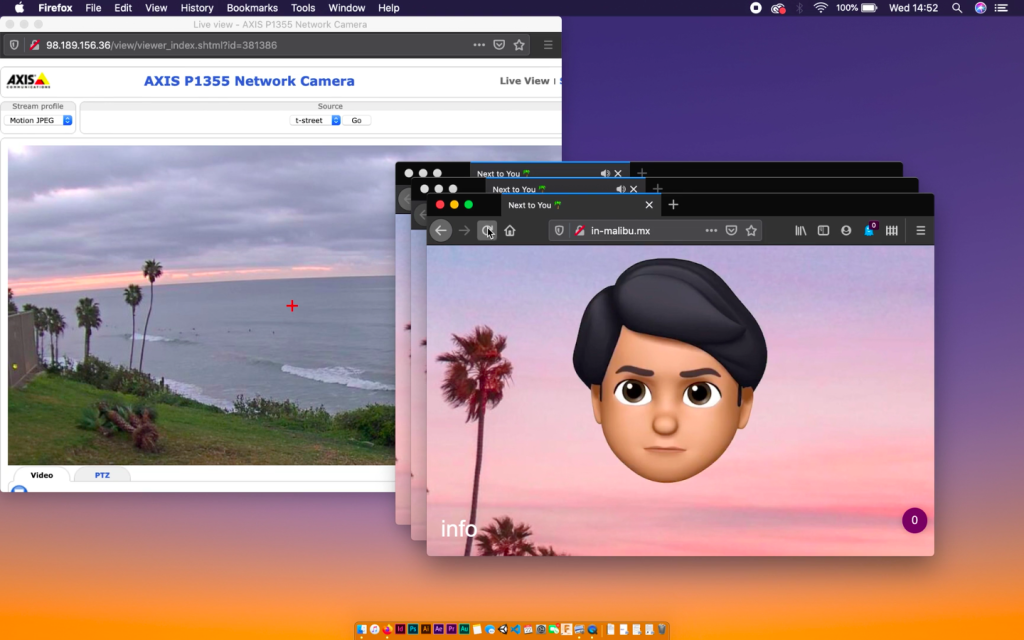
THE IMPORTANCE OF FREUDO-LACANIAN PSYCHOANALYSIS TO LIBERATION PRAXIS
Word Count: 2,857 |
Download this article
by •
005: DAZE
with NEXT TO YOU (IN-MALIBU.MX)
a video by RODRIGO NAVA RAMÍREZ
In this essay, I will argue for the importance of Freudo-Lacanian psychoanalysis to liberation praxis by briefly unpacking some of the former’s central concepts: language, the unconscious, the Gaze, and singularity. But before I do that I would like to begin by defining liberation praxis. Praxis, a key signifier for both Karl Marx and Paulo Freire, is the merging of theory and practice or reflection and action. In this sense, psychoanalysis, as a science of the unconscious, is praxis: a theory of psychical structures (neurosis, perversion, and psychosis), as a function of different forms of negation (repression, disavowal, and foreclosure), which is practiced in the clinic. The praxis of psychoanalysis is dyadic (between analyst and analysand) and dialectical in the tradition of Socrates, Hegel, Marx, and Freire. The dialectic between analyst and analysand echoes the dialectic between the subject and the Other (i.e., any representative of the Symbolic order for the subject). This Symbolic Other is distinguished from Imaginary others (i.e., other egos) because it is more abstract given its representative function, which transcends any actual being. The Symbolic order is the register of language and law in which we are born and which, subsequently, forms us as subjects to it. The praxis of psychoanalysis is radical because its dialecticism is not merely dialogical but, more significantly, psychosocial—that is, psychoanalysis is concerned with the fantasmatic link between the subject and the Other. Similarly, liberation (as opposed to freedom) is a collective praxis, which is led by the oppressed but whose goal is the humanization of all because oppression dehumanizes everyone.
The meaning of the concept of the dialectic has changed over time: for Socrates it was the dialogue between two individuals, for Hegel it was the universal antagonism between two ideas (synthesis and antithesis), for Marx it was the historical struggle between two classes (bourgeoisie and proletariat), and for Freire it was the codependent relationship between the oppressor and the oppressed. The analyst and the analysand are certainly two individuals, but they can also represent two ideas (objet a and barred subject), come from different classes, and reenact oppressive dynamics that exist in the larger social context.
The objet a is the object-cause of desire, a fantasmatic or impossible object, which we think we lost even though we never had it in the first place; subsequently, we imagine it will bring us plenitude once realized, but, paradoxically, failing to realize the objet a is a source of (masochistic) jouissance for the subject. Therefore, the barred subject, who is barred by language because he or she must desire through the Other, is a lacking subject.
At the heart of psychoanalytic praxis is a Real (dialectical) antagonism between the individual and the collective: we are who we are as a function of our place in the collective, yet our being is a symptomatic form of existence (or singularity), which also leads to our uneasiness in culture (e.g., we can only desire through the Other, but the Other may be racist). In sum, we yearn to become liberated from oppressive individuals, ideas, and groups, which are the source of our pathologies. But this yearning is inherently psychosocial; therefore, liberation praxis is the collective liberation of all speaking beings at the very least, but I would go further, following the Bodhisattva ideal, and ambitiously call for the liberation of all sentient beings.
The reality of our interbeing provides us with more clarity as we think and act through the ongoing environmental breakdown, which is a function of a modern/colonial opposition: man vs. nature. Man versus nature is not dialectical; it is a binary opposition that follows an either/or rhetoric, which is sustained by a self-over-other logic. On the contrary, a dialectical approach, like transcendental materialism, situates the human subject in the materiality of the environment without reducing him or her to some form of biological essence, wherein there would be no distinction between speaking beings and non-human animals. Similarly, the human subject cannot be reduced to some form of cultural essence, which is the narcissistic tendency of nationalism. The human subject is the Real gap between biology and culture, he or she is the traumatic enjoyment that results from desiring in the face of biological needs and cultural demands. Biological and cultural racists reduce the other to an essence in an effort to suture this Real gap that characterizes all speaking beings. To interbe with the environment is not a statement about ontological identity (i.e., being = environment), but a recognition of our complex relationship with all that is: being-in-the-environment.
LANGUAGE
Lacan famously wrote in his Écrits, “the unconscious is the Other’s discourse” (emphasis in original). Psychoanalysis, known facetiously as the talking cure, is radical in its emphasis on language as the site for unknotting complexes in the psyche. This insight stems from the reality that we are born into language, a strange and complicated system that exists before and outside us, but on which we heavily depend for the formation of our subjectivity. Before entering into language, we are instinctive animals with biological needs. Once we enter into language, as mediated by our primary caregivers, we become barred and caught between our biological needs and the cultural demands imposed upon us by our primary caregivers through language and law. Having internalized this strange and complicated system called language, we begin to articulate our desire through it. However, what we want is unconscious and comes to us from outside because we have internalized a system not only of communication but also of morality, which is how repression works. Subjectivity then is the complex of signifiers that informs how we desire and how we enjoy our symptoms.
Because the unconscious is the Other’s discourse and is, as Lacan writes in The Four Fundamental Concepts of Psychoanalysis, “structured like a language,” it is inherently psychosocial and not personal. We desire through the Other, we desire the Other, and we desire what the Other desires. Desire is a linguistic phenomenon that has to do with the unconscious movement of signifiers (e.g., metaphoric condensation and metonymic displacement) as a function of repression. In other words, we do not consciously know what we want, but we can learn about what we desire and how we enjoy from the way we speak, dream, and joke. For example, in Decolonial Psychoanalysis, I show the metaphoric condensation at the heart of the ‘war on terror’ discourse, wherein war = terror. Then I illustrate how this discourse is sustained by an Islamophobic/Islamophilic fantasy that involves metonymic displacement: Muslim → terrorist. This psychoanalytic emphasis on language is not a denial of the body; on the contrary, language is inscribed on our very bodies, it is materially embodied, which is why we experience symptoms that do not have a biological cause, yet are bodily symptoms.
In sum, liberation praxis, as a process, entails a reflection on the way oppressive language works along with its material effects. In other words, liberatory practices are enacted through liberatory discourses. However, in case I am misunderstood to be promoting the policing of speech which would be antithetical to the principle of free association, I must emphasize that, regarding liberatory discourses, the oppressed have a duty to cut through any and all fantasies that suture the traumatic Real. Hence, the importance of the dialectic as the recognition of the irresolvability of Real impossibility, which is a key feature of any future politics.
THE UNCONSCIOUS
The unconscious decenters the ego and sheds light on the primacy of the psychosocial over the psychic. Consciousness-raising is important, but it will not succeed without unconsciousness-raising, which is a political intervention at the level of the Other’s discourse. In other words, to be antiracist one has to also speak of an antiracist unconscious, which implies transforming the culture of racism and replacing it with an antiracist culture. To put it differently, the subject cannot be antiracist as long as the Other is racist. The paradoxical question of racism is: how do we acknowledge human, and cultural, differences beyond racial categories without being color-blind? In other words, we must collectively come to terms with both the denial of racism (which is also a denial of colonialism) and the overpresence of racial discourses as an effect of religious, scientific, and cultural racisms. We do not yet have a post-racial language and we may not have one anytime soon since undoing modernity/coloniality may take hundreds of years, but we can at least try to prefigure a transmodern/decolonial world-system through our liberation praxis.
THE GAZE
Unfortunately, many confuse the look with the Gaze. The confusion can be traced back to early psychoanalytic film theory, which is known as screen theory. In her 1975 essay, Visual Pleasure and Narrative Cinema, Laura Mulvey wrote about film spectatorship qua the ‘male gaze’. While this phrase is popular today and sounds feminist, it is actually non-psychoanalytic and maybe even antifeminist since it equates spectatorship with maleness. In her 1989 essay, The Orthopsychic Subject: Film Theory and the Reception of Lacan, Joan Copjec not only cleared the confusion in psychoanalytic film theory, she also inaugurated Lacanian film theory by anchoring it in the register of the Real, that which cannot be symbolized. The confusion between the look and the Gaze is a function of screen theory being more Foucaultian than Lacanian, wherein the Gaze is conceptualized in terms of panopticism as exemplified by the all-seeing guard in Jeremy Bentham’s panopticon. The panoptic look is shot through with misrecognition, for it is essentially an Imaginary look of mastery that has to do with a fantasy of power, rather than desire per se.
The anamorphic Gaze, on the other hand, is on the side of the screen (not the spectator), or the prisoners (not the guard). In other words, the Gaze is always on the side of the object (not the subject), and it is the form of the objet a in the scopic drive. To put it differently, the Gaze is that which we cannot see but which causes our desire through its absence. Therefore, a non-identity politics based on this insight is not grounded in Imaginary identifications, but in the alignment of our desire and, consequently, the jouissance of our solidarity.
Lacan’s most famous example of the Gaze is a 1533 painting by Hans Holbein called The Ambassadors. In the painting, Holbein used a technique called anamorphosis, which resulted in a distorted human skull at the bottom center of the painting that can only be seen from specific angles. The skull, which symbolizes the absolute master (death), stains the painting by reminding viewers that the vain merchants who are showing off their wealth are mortal beings as are the viewers. Because anamorphosis drives the viewer to move in order to see the distorted object, this example demonstrates that the viewer is not a passive recipient of the painting but an active participant (a subject) whose unconscious desire is caused by the painting’s Gaze. The same principle is at work in cinema, but given the dynamic techniques of film there are more opportunities for spectators to experience the Gaze. Todd McGowan has written extensively on the filmic Gaze, most importantly in The Real Gaze: Film Theory After Lacan.
The example that I would like to use is Albrecht Dürer’s (1525) Draughtsman Drawing a Recumbent Woman. The draughtsman on the right exemplifies the subject’s male look; however, the recumbent woman on the left represents the objet a‘s anamorphic Gaze. In other words, she is not only objectified by the male look, but also subjectifies the draughtsman by causing his desire—like an analyst vis-à-vis an analysand in the clinic. The Real Gaze is a more nuanced approach than the ‘male gaze’ one, which actually negates female subjectivity. The look–Gaze dialectic may be applied beyond sexual difference to colonial difference, for instance, wherein we can speak of the colonial look and the decolonial Gaze.
SINGULARITY
There is a transversal link between the singular and the universal. It is this link which illustrates the continued relevance of psychoanalysis as a science of the unconscious. However, given the specific context of the development of psychoanalysis in Austria in the late nineteenth and early twentieth centuries, we must also speak of the pluriversal in order to acknowledge the cultural difference between the Global North (the West) and the Global South (the rest). This cultural difference is Real as a function of modernity/coloniality since 1492. In other words, there is universality to psychoanalytic concepts vis-à-vis modern subjectivity, but this universality must be put into question if we are interested to account for transmodern subjectivity (i.e., subjects of modernity and its alterity).
Identity politics is premised on the primacy of particularity, which is rooted in a form of cultural essentialism. The question of cultural difference for me is one of language and materiality vis-à-vis modernity/coloniality. While I was born and raised in a particular culture (Egypt), of which I am unashamedly proud, I am a singular subject who can only represent himself. My link to my particular culture is both linguistic and material, but that does not mean that my politics is premised on my identification with being Egyptian. On the contrary, I am much more interested in identifying with a politics of affiliative solidarity that links singular transmodern subjects with a pluriversal process of liberation, that is, decolonizing the modern Other. Decolonizing the modern Other, along with its colonial unconscious, prefigures the transmodern Other and the decolonial unconscious. While the oppressed are the subjects leading the way to liberation, the politics actualized in this praxis is global in scale, for transmodernity is the best of modernity and its alterity and decoloniality is the humanization of all.
Beshara, Robert K. Decolonial Psychoanalysis: Towards Critical Islamophobia Studies. Routledge, 2019.
Copjec, Joan. “The Orthopsychic Subject: Film Theory and the Reception of Lacan.” October, vol. 49, 1989, pp. 53-71.
Lacan, Jacques. Écrits: The First Complete Edition in English. Translated by Bruce Fink, Norton, 2006.
—. The Four Fundamental Concepts of Psycho-Analysis. Translated by Alan Sheridan, Karnac Books, 2004.
McGowan, Todd. The Real Gaze: Film Theory after Lacan. SUNY Press, 2012.
Mulvey, Laura. “Visual Pleasure and Narrative Cinema.” Screen, vol. 16, no. 3, 1975, pp. 6-18.
NEXT TO YOU (IN-MALIBU.MX)
To be territorial is to assert a relationship between ourselves and a place. These bonds fortify a sense of meaning and identity. California represents a cultural and geographical centre: the birthplace of “cool”, a place of endless sun, beaches and possibilities. A mythical image of the promised land, the ideal lifestyle.
It is also the last place I visited before being deported and banned from the US in 2017.
Next to You (in-malibu.mx) is a longing for a place that the artist can no longer access. It questions the meaning of physical barriers in times of hyper-globalisation.
Originally designed as a piece of desktop choreography, a website, the work is presented here as an adapted video piece. Within it, Nava Ramirez captures his facial expressions through the “memoji”, the features of which are based on the FBI profile that was filed after his deportation from the US.
The website itself in-malibu.mx is hosted in the US, causing its function to be tied to the Pacific Time Zone; while its “birthdate” of December 3, 2017 coincides with the date the artist was deported from LAX airport, California. Since the website’s birthdate, the song “Malibu” (Miley Cyrus) – a hyper-digitized lament – has been sung by the memoji-rendered artist 395,011 times, and counting. As the virtual windows into the Pacific Time Zone are opened, the livestream of the artist’s image multiplies, making it possible, for a moment, for them to exist within the out-of-bounds of America. As the windows are closed, so the artist is removed from sight.
The work in website-form cannot be accessed from the US. When the artist is allowed to re-enter the country, he will remove the geographical restriction placed on its access.
– Rodrigo Nava Ramírez

ROBERT K. BESHARA writer
Robert K. Beshara is the Director of the Critical Psychology certificate program at The Global Center for Advanced Studies, Ireland/USA. He is the author of Decolonial Psychoanalysis: Towards Critical Islamophobia Studies (2019) and Freud and Said: Contrapuntal Psychoanalysis as Liberation Praxis (2020), the editor of A Critical Introduction to Psychology (2019), and the founder of criticalpsychology.org, a free resource for scholars, activists, and practitioners.
RODRIGO NAVA RAMÍREZ artist
Rodrigo Nava Ramírez is a Glasgow-based web programmer and artist from Mexico City. His practice is centered around how our understanding of movement is shaped by our relationship with technology. He uses the Internet as both medium and territory to explore new ways of engaging with spaces that are materially and temporally restricted.
© Copyright for all texts published in Stillpoint Magazine are held by the authors thereof, and for all visual artworks by the visual artists thereof, effective from the year of publication. Stillpoint Magazine holds copyright to all additional images, branding, design and supplementary texts across stillpointmag.org as well as in additional social media profiles, digital platforms and print materials. All rights reserved.



